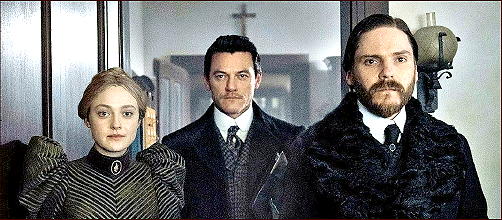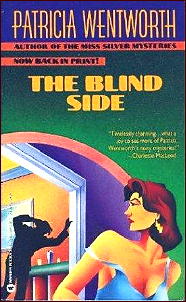January 2018
Monthly Archive
Tue 23 Jan 2018
Posted by Steve under
Reviews[8] Comments
REVIEWED BY WALTER ALBERT:
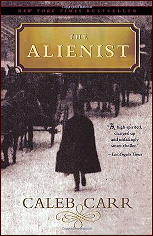
CALEB CARR – The Alienist. Laszlo Kreizler #1. Random House, hardcover, 1994. Bantam, paperback, 1995. TV adaptation: A ten-episode series premiered on TNT on January 22, 2018, with Daniel Brühl as Dr. Laszlo Kreizler, Luke Evans as John Moore, and Dakota Fanning as Sara Howard.
The time is 1896, the place, New York City, at a time when Theodore Roosevelt, president (1895-1897) of the Board of Commissioners of New York City’s Police Department, is attempting to rid the Department of its corruption and inefficient antiquated methods, and open it up to “modern” ideas and procedures.
Roosevelt’s struggle with the law enforcement establishment are mirrored in the attempts of his friend, Dr. Laszlo Kreizler, a psychologist (or alienist) to reform a profession opposed to believing that psychopaths are “produced by extreme childhood environments and experiences and [are] unaffected by any true pathology. Judged in context, the actions of such patients could be understood and even predicted (unlike those of the truly mad).” Or as the reporter-narrator puts it, “[we] set out on the trail of a murderous monster and ended up face to face with a frightened child.”
Kreizler and Roosevelt are seen as threatening not only the beliefs of a profession but society itself. Thus, Kreizler and his team, hastily formed to discover the sadist who is killing and mutilating boy prostitutes, must operate secretly, and independently of the police.
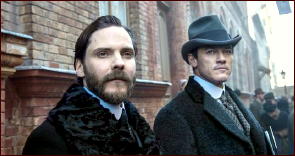
Carr has some of the ability to bring to life a historical period but does not quite seem to make the period as immediate as the present. His portrait of a period has more of the appearance of a brilliantly realized oil painting. It’s no less effective, perhaps, but it lacks the evocative power of cinematic realism. In one, the tableau moves; in the other, it glows with something of a romantic sheen.
Carr doesn’t escape what might have become the conventions of the serial murder novel; in particular, the use of another murderer to shed some light on the mind of the subject of present investigation. As in Thomas Harris’s Red Dragon and The Silence of the Lambs, the investigator visits the incarcerated “specialist.” This time, it’s one Jesse Pomerpy, described in a manner that has something of the gothic flavor of the Hannibal Lector descriptions: “Pomeroy was wearing a heavy set of shackles on his wrists, and an iron ‘collar cap’ rested on his shoulders and surrounded his head. This latter device , a grotesque punishment for particularly unruly prisoners, was a two-foot0high barred cage. Despite both the shackles and the collar cap, however, Jesse had book in his hand and was quietly reading.”
The Alienist is in the fourth spot this week on the NY Times bestseller list. There are apparently a lot of readers whose “escape” reading is hardly an opening onto a panorama scarcely less horrific than the one depicted in the daily newspaper and on TV. Highly recommended, if you can stomach the graphic descriptions of mutilated bodies and irruptions of violence.
— Reprinted from Walter’s Place #102, August 1994 (very slightly revised).
Mon 22 Jan 2018
REVIEWED BY DAN STUMPF:

LES INTRIGANTES. L’Alliance Générale de Distribution Cinématographique / Memnon Films, France, 1954. Also released as The Plotters and The Scheming Women. Raymond Rouleau, Jeanne Moreau, Raymond Pellegrin, Etchika Choureau, and Paul Demange. Written and directed by Henri Decoin, from a novel by Jacques Robert.
A fitting title for an intriguing not-quite-murder mystery that manages to quote from Alfred Hitchcock without slavishly imitating him. Set in a Theatre (like Stage Fright, and with a plucky young girl determined to prove her lover innocent) the story benefits from a marvelous sense of place, and a cast of vividly evoked actors, dancers, writers, wives etc., adding character and color to the proceedings.

The hook here is that we never see the actual killing, and in a visual medium like film, this is important. Thus we never know if the hero (Raymond Rouleau) is guilty or not, but he seems like a nice guy, even when the evidence starts mounting against him.
The killing itself involves the co-owner of the theatre where Rouleau is the other co-owner, falling from a catwalk. The only other person there at the time was Rouleau, who was on the catwalk with him. A bit suspicious that, but the Police haven’t got a case until Rouleau’s secretary (a fine beady-eyed portrayal by Raymond Pellegrin) says he was there and saw the co-owner get pushed. Also about this time, documents surface showing that the dead man was thinking of pulling out financial support, but with his death, Rouleau inherits everything.

So the story becomes not an attempt to prove Rouleau innocent, but to prove him not guilty. Which pits the plucky young girl who loves Rouleau against a lot of sophisticated and complex characters who would profit if he’s convicted — including Jeanne Moreau, looking very Dietrich-esque as his unfaithful wife.
There’s some strong writing and acting here, and there’s a cute in-joke: a little guy who keeps popping up wanting to talk to Rouleau and always just missing him. About the 3rd or 4th time he showed up, I figured he had some important clue to the whole thing, but everybody just maddeningly ignores him till the end — when there’s a surprise that gave me a hearty chuckle.
This isn’t easy to find, but those who can get a copy will discover an enjoyable and original little film to remember.
Mon 22 Jan 2018
Posted by Steve under
Reviews1 Comment
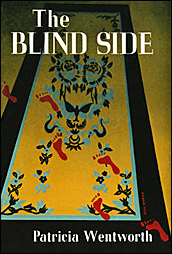
PATRICIA WENTWORTH – The Blind Side. Inspector Ernest Lamb #1. Hodder & Stoughton, UK, hardcover, 1939. J. B. Lippincott, US, hardcover, 1939. Popular Library #66, US, 1945 (?). Warner, US, paperback, 1991. Dean Street Press, UK, trade paperback, 2016.
Inspector Lamb showed up in three of Patricia Wentworth’s over 60 works of detective fiction, but based on this first one, to call him a series character, as all the mystery reference sources do, is stretching it quite a bit. All he does in The Blind Side is be there as someone representing the police end of things. Otherwise he’s a complete nonentity. He really doesn’t do any investigating. Perhaps he had more to do in the other two. This one’s pretty much an “in family” case of deduction.
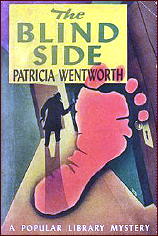
Dead is an obnoxious middle tenant on one floor of the building he owns. My use of the word obnoxious is based on the fact that as the book opens he about to evict a maiden aunt who has lived in the flat next door for many years and has nowhere else to go.
He is also an exceptional cad with women, and the gentlemen who he steals them from aren’t at all happy about it. So when he ends up dead, we the reader are not at all surprised. Mucking the investigation up is the fact that everyone who had a motive seems to have been in his apartment that night, one sleepwalking (she says) and having the bloody bare feet to show for it, and another (one of the jilted suitors) on a drunken binge after threatening murder the entire evening before.
I’m not sure how fair the play is in this novel. I don’t think it’s as tightly written as any of Christie’s around this same time period, but with all of the time tables, family charts, alibis, and false trails, I certainly had a lot of fun with it.
Sun 21 Jan 2018
REVIEWED BY DAVID VINEYARD:

CROSSTRAP. Screen Entertainment Company/ Unifilms, UK, 1962. Laurence Payne, Bill Nagy Jill Adams, Zena Marshall, Gary Cockerell. Screenplay by Philip Wrestler, based on the novel The Last Seven Hours by John Newton Chance. Directed by Robert Hartford-Davis.
This no-budget British suspense film has its moments and is based on a novel by popular British writer John Newton Chance (aka SF author John Lymington, among others).
Geoff and Sally (Greg Cockerll and Jill Adams) are a mystery writer and his bride off on a holiday to a remote little spot so they can have time alone and he can finish his book, but no sooner have they arrived than they find a body, and a gangster (Bill Nagy) who won’t let them go.
Soon the boss, Duke (Laurence Payne) arrives with French girlfriend Reva (Zena Marshall) and two others in tow. They’ve just pulled a jewel heist in London and killed a policeman, and meanwhile they are awaiting the plane due to land at a nearby airfield and fly them out to France.

There are complications though, like the dead man, and who killed him, and did he betray Duke and the gang? Was it a rival gang that Duke fears has followed them? Then there is Duke himself, a psycho if there ever was one, who has eyes for Sally and would like to see Geoff dead to clear the way.
None of which makes Reva happy, and since she is key to their getaway in France that matters.
Pretty soon the rival gang arrives and a siege begins, Duke tries to use Geoff as a goat to get him killed, but only succeeds in getting him captured, and as the time nears for the plane the gang can’t afford to stay penned down and must make a break for it.
It builds to a fairly exciting finish, with Duke getting his just reward from Reva and Geoff and Sally escaping by the skin of their teeth.

In a forgiving mood Crosstrap kills a bit over an hour pretty well. Payne, himself a successful mystery writer and television’s Sexton Blake, is the main attraction acting-wise and seems to be having fun as Duke. Adams and Marshall are nice to look at and neither embarrasses themselves in their performances. Nagy, you may not know by name, but will recognize if you have seen many Brit films of the period, the same for most of the rest of the cast.
Of Cockerll, let us be generous and say he is adequate.
Currently this is available on Amazon Video. I can only say I’ve spent worse hours.
Sat 20 Jan 2018
Posted by Steve under
Reviews[5] Comments
REVIEWED BY BARRY GARDNER:
JOHN SANDFORD – Night Prey. Lucas Davenport #6. Putnam, hardcover, 1994. Berkley, paperback, 1995.
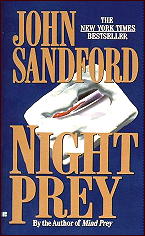
Sandford is really John Camp (or is it vice versa?) under which name he wrote two books about a computer whiz/criminal which I liked a lot — The Fool’s Run and The Empress File. I guess he’s doing too well with the “Prey” series to do any more of those, though. Pity — they were a lot better, to my taste.
Lucas Davenport is back with the Minneapolis PD, this time as a Deputy Chief in charge of special projects, To no one’s surprise, including Lucas’s and ours, his next project turns out to be a serial killer. An abrasive lady state cop has come to Davenport’s chief with a file that indicates one is loose in the Twin Cities area, and that his timetable is shortening.
Davenport’s chief doesn’t feel she can afford to ignore the possibility, and assigns him and a task force to work with the woman on the case. Sure enough, more blood is spilled, and then more.
Would someone tell me why I used up a precious hour or two reading this? Please? I know I don’t like serial killer books, particularly those which alternate viewpoints with the killer and the pursuer, and I knew that was what this was and read it anyway.
Sandford’s strengths are his often chilling portraits of serial killers, his strong central character of Lucas Davenport, and his excellent storytelling ability. All are in full evidence here. If I were going to read any more s.k.’s, these would be on my shelf right alongside Thomas Harris. But I’m not, I swear. Stop me before I do it again, somebody.
— Reprinted from Ah Sweet Mysteries #14, August 1994.
Bibliographic Updates: John Sandford’s real name is John Camp. He wrote his first two books, the ones Barry mentions, under his own name, although they were both reprinted later as by Sandford. The computer whiz in those books was a fellow named Joe Kidd. There have been two later books in the series, published as by Sandford.
As of this year and the publication of Twisted Prey there will be 28 books in the Lucas Davenport series, and ten more with Virgil Flowers, who is a member of the Minnesota Bureau of Criminal Apprehension, and who reports to Lucas Davenport.
Sat 20 Jan 2018
Posted by Steve under
General[5] Comments
I’ve been selling mystery paperbacks by mail since the 1970s, at first mostly as a way to add to my own collection, but in recent months more and more as a means of diminishing the size of the collection itself. Except for the first few issues of Mystery*File, which were a combination of sales lists and short articles and checklists, I’ve generally kept the two activities separated.
This morning I woke up thinking, why? And I’ve changed my mind about that. Please forgive this commercial intrusion, if indeed I need ask your forgiveness, but here’s a first step in that direction. Follow the link below to a list of all of the mystery paperbacks I have listed on Amazon. You can order them there as well, but discounts will be offered if you purchase from me directly.
The webpage is rather crudely built right now, but the link should work. If not, let me know, and I’ll work the bugs out ASAP.
Mystery Paperbacks
Fri 19 Jan 2018
REVIEWED BY JONATHAN LEWIS:

THE DAY OF THE JACKAL. Universal Pictures, 1973. Based on the book by Frederick Forsyth. Edward Fox as the Jackal, Michel Lonsdale as Deputy Commissioner Claude Lebel, Adrien Cayla-Legrand as President Charles de Gaulle. Director: Fred Zinnemann.
For a captivating thriller/police procedural, The Day of the Jackal also manages to keep the viewer at a safe distance. Unlike some movies in that genre that succeed mainly due to propelling the viewer straight into the action, the semi-documentary feel of the film allows for a sense of detachment on the part of the audience. But this does not mean that the film is not compelling and deeply engrossing.

Directed by Fred Zinnemann (High Noon), this British-French production is one of the better political thrillers adapted to film from a best selling novel. Indeed, it’s the film’s very mechanical approach, due in large part to brilliant editing by Ralph Kemplen (who won a BAFTA for his work), which makes this cinematic adaptation of Frederick Forsyth’s a superb work of 1970s commercial cinema.

Edward Fox, then a largely unknown British actor, portrays the eponymous Jackal, a high priced assassin-for-hire. He has been hired by renegade members of the OAS, a coterie of right-wing French nationalists who blame President Charles de Gaulle for allowing France to lose possession of Algeria. They have hired the Jackal to assassinate De Gaulle. Much of the film centers upon the Jackal’s movement through various European countries as he plans his act of violence, acquires a specially made rifle for the occasion, and assumes various identities along the way. That is one part of the story and is very much part of the thriller genre.

The other part, which is a police procedural, follows the French authorities as they attempt to both discern the identity of the Jackal and to stop him from killing the French president. Leading the investigation is the determined, if somewhat emotionally distant Deputy Commissioner Claude Lebel (Michel Lonsdale) who is nothing if not methodical. Lonsdale, who many American viewers will remember as Hugo Drax in Moonraker (1979), is nearly flawless in his portrayal of the unflappable policeman who trusts no one.
A final word about the movie: the Jackal is a ruthless, heartless, and cold calculating killer who is more than willing to employ violence to stop anyone who gets in his way. Zinnemann chose to film many of the scenes in which the Jackal kills so that the viewer actually doesn’t see the killing, at least not the brutality of it. Instead of shielding the audience from the Jackal’s ruthlessness, however, this aesthetic choice – one that fans of films noir will be quite familiar with – only serves to heighten it.
Thu 18 Jan 2018

DÉJÀ VU. Touchstone Pictures, 2006. Denzel Washington, Paula Patton, Val Kilmer, Jim Caviezel, Adam Goldberg, Elden Henson, Erika Alexander, Bruce Greenwood. Director: Tony Scott.
This is a movie that begins with a bang, no doubt about it, with a ferry filled with enlisted naval men and their families being blown up and destroyed by a terrorist in New Orleans. Asked by the FBI for his assistance on the case is a crack ATF agent named Doug Carlin (Denzell Washington). What strikes him as strange is that when he finds the partially burned body of a young woman who has floated ashore is that she died before the explosion.

Intrigued, he also learns that the team he is working with has access to a new satellite surveillance capability of tracking anyone almost anywhere. The catch is that what can be seen is limited to viewing events that have already taken place, an always consistent four days ago. Carlin suggests that they not spend their time looking at the ferry in the past, but focus instead on the young woman’s life.
What he does not known, and as it turns out [SEMI-SPOILER ALERT] that what they are viewing is the actual past (abruptly switching gears and making this a science fiction movie rather than the run-of-he-mill action thriller it has been up to this point) and soon enough all kinds of time-travel paradoxes come into play, enough, I would imagine, to make an ordinary viewer’s head spin.

I’ve been reading this kind of stuff for over 60 years, and while some of what happens goes down very, very well, there are two gaps in the continuity of things that — and I hate to say it — pretty much spoiled the final thirty minutes or so for me. As I understand it, and this may be entirely hearsay, the screenwriters spent several years making sure that all of the bugs were out, and the director decided to skip some of their work in favor of a large car chase somewhere close to the end of the movie instead.
If so, it’s too bad. Denzell Washington is as good as he always is, but if this movie isn’t as good as it could have been, and it isn’t, it’s not through any fault of his.
Wed 17 Jan 2018
IT IS PURELY MY OPINION
Reviews by L. J. Roberts
CHARLES FINCH “Gone Before Christmas.” Charles Lenox #10.5. eBook novelette. Minotaur Books, December 2017. Setting: London-1887.

First Sentence: The two brothers stood motionless upon the top step of a fine London townhouse, each with arms crossed, assessing a correspondingly motionless pair of trees propped against a railing.
Lt. Ernest Austen of the Grenadier Guards has disappeared. Charles Lenox is trying to establish his detective agency, the first of its kind, but having little luck. Even Scotland Yard is so baffled, they’ve agreed to having Lenox consult. Solving this case would give him credibility and recognition. But can he solve it?
One of the many things to love about Finch’s writing is his use of humor, whether it’s about life, death— “Death is the great spiritual adventure toward which all living things mush lean forward in hope and humility, in neither fear or anger.†–and Christmas trees.
It is always interesting learning about the customs of a period, and that they relate to Christmas makes them even more so. The tradition of Lenox’s father is quite progressive for the time. Yet one of the best things about a prequel, is to learn more about the protagonists and their history.
Finch creates wonderful analogies— “France and England were rather like an unhappy couple out to supper at friends’: not presently at war, except in the sense that they were continually at war.†His descriptions are evocative— “There was evidence all over it of wealth, and ancient lineage—tapestries on the walls, enormous hunting scenes in oils, tables of marble….â€
His use of language is a treat— “…he discovered that the next train was in ninety minutes. He set out to see the wonders of Ipswich for himself. When that was finished, he had eighty-seven minutes left….†It is elements such as these, along with learning bits of information such as how the term “butler†came to be, that makes reading Finch such a pleasure.
“Gone Before Christmas†is a lovely story for the holidays with just the right balance of seriousness and sentimentality.
Wed 17 Jan 2018
REVIEWED BY DAN STUMPF:

DOCTOR OF DOOM. Cinematográfica Calderón S.A., Mexico, 1963. Originally released as Las luchadoras contra el médico asesino. Young America Productions Inc., US, English dubbed version. Lorena Velazquez, Armando Silvestre, Elizabeth Campbell, Roberto Canedo, Chucho Salinas, Chabela Romero — and Gerardo Zepeda as “Gomar.†Written by Alfredo Salazar. Directed by Rene Cardona. American version produced by K. Gordon Murray.
A film of surreal badness and genuine delight, this one has it all: wrestling women, mad scientist, ape-man, gangsters….. everything but cowboys, and I suspect they may have been in the original Mexican version.

In fact, it may be impossible to fully appreciate the vision of Luchadoras/Asesino from what “Mexploitation†producer K. Gordon Murray turned into Doctor of Doom, but enough survives to boggle the mind.
The plot is admirably straightforward: A mad doctor (imaginatively dubbed “The Mad Doctorâ€) has been kidnapping women off the street and removing their brains. We know, but the police don’t, that the flakey physician has been trying to transplant the brain of a gorilla into their skulls — always a project of dubious medical value, but there you are — but they tend to die once their brains are removed; thoughtless of them.
(See what I did there? “Thoughtless?â€) Anyway, I should add here for the sake of clarity that we don’t see The batty bone-setter’s face, but he’s aided by a cringing medical assistant, a bunch of small-time hoods, and a half-man/half-ape named Gomar, who has super strength and can be fitted with a bullet-proof suit when the heat is on.

So right away we have the quintessential elements of old horror films and serials. The Police (Canedo & Salinas) are puzzled, in the time-honored tradition of monster-movie cops, but things take a turn when the demented doctor snatches the sister of pro-wrestler Gloria Venus (Lorena Velazquez, who looks unsettlingly like young Mary Tyler Moore) who also happens to be Canedo’s girlfriend. Joined by Golden Rubi (Campbell) the cops and the grapplers set out to get the bad guys.
Which doesn’t involve a lot of detective work, because the screwy scientist has decided that what he needs for his project is a female wrestler (only logical when you stop to think about it) and while Venus and Rubi are after him, his hoods and Gomar are after them.

Hang on a minute. I need to say here that because of legal restrictions south of the border in those days, this was made (ostensibly) as three short episodes which were then combined into a single feature film. Go figure. Anyway, the goons out after the girls kidnap the cops instead (!?) who are then rescued by the wrestling women, and everything ends happily except that the cracked quack has escaped with Gomar.
Part two is more of the same, this time with an emphasis on discovering the real identity of the potty professor. Since there’s a character who’s been hanging around since chapter one trying to be helpful and pleasant, well… draw your own conclusions. Suffice it to say that we get more kidnappings, a fracas in the same Mad Lab that got busted up previously, and a fire that leaves the daffy doctor disfigured and thirsty for revenge.

All this, though, was just a set-up for the Big Finish, as the paranoid practitioner captures another wrestling woman, plants Gomar’s brain in her skull, thus giving her super-strength (!?!) and sets her up as a masked rival wrestler to kill Gloria Venus in the ring, in a baroque vengeance worthy of Fu Manchu or a Sergio Leone Western, the whole thing wrapping up like a bizarre mix of Rocky and White Heat.
What Doctor of Doom lacks in finesse — and it lacks a lot — it makes up in exuberance and a not-quite innocent charm, like an old Mascot serial or a horror flick from PRC. Director Rene Cardona, who launched wrestling super-star Santo into a cinematic career, handles it with just the right slap-dash energy and enough inattention to detail to keep things in constant motion.
I’ll only add for you trivia completists out there that Doctor of Doom launched Lorena Velazquez into a short-lived series (see Wrestling Women vs. the Aztec Mummy) and even Gerardo Zepeda returned as Gomar in a semi-remake that surfaced here as Night of the Bloody Apes.
« Previous Page — Next Page »


